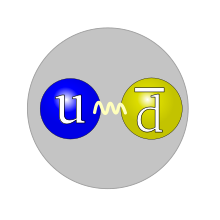
Back Pion (deeltjie) Afrikaans بيون Arabic Пі-мезон Byelorussian Пион Bulgarian Pion Breton Pion BS Pió Catalan Pion Czech Pion Danish Pion German
 The quark structure of the positively charged pion. | |
| Composition |
|
|---|---|
| Statistics | Bosonic |
| Family | Mesons |
| Interactions | Strong, weak, electromagnetic, and gravity |
| Symbol | π+ , π0 , and π− |
| Antiparticle |
|
| Theorized | Hideki Yukawa (1935) |
| Discovered |
|
| Types | 3 |
| Mass | |
| Mean lifetime | |
| Electric charge |
|
| Charge radius | |
| Color charge | 0 |
| Spin | 0 ħ |
| Isospin |
|
| Hypercharge | 0 |
| Parity | −1 |
| C parity | +1 |
In particle physics, a pion (or a pi meson, denoted with the Greek letter pi:
π
) is any of three subatomic particles:
π0
,
π+
, and
π−
. Each pion consists of a quark and an antiquark and is therefore a meson. Pions are the lightest mesons and, more generally, the lightest hadrons. They are unstable, with the charged pions
π+
and
π−
decaying after a mean lifetime of 26.033 nanoseconds (2.6033×10−8 seconds), and the neutral pion
π0
decaying after a much shorter lifetime of 85 attoseconds (8.5×10−17 seconds).[1] Charged pions most often decay into muons and muon neutrinos, while neutral pions generally decay into gamma rays.
The exchange of virtual pions, along with vector, rho and omega mesons, provides an explanation for the residual strong force between nucleons. Pions are not produced in radioactive decay, but commonly are in high-energy collisions between hadrons. Pions also result from some matter–antimatter annihilation events. All types of pions are also produced in natural processes when high-energy cosmic-ray protons and other hadronic cosmic-ray components interact with matter in Earth's atmosphere. In 2013, the detection of characteristic gamma rays originating from the decay of neutral pions in two supernova remnants has shown that pions are produced copiously after supernovas, most probably in conjunction with production of high-energy protons that are detected on Earth as cosmic rays.[2]
The pion also plays a crucial role in cosmology, by imposing an upper limit on the energies of cosmic rays surviving collisions with the cosmic microwave background, through the Greisen–Zatsepin–Kuzmin limit.
- ^ a b c d Zyla, P. A.; et al. (Particle Data Group) (2020). "Review of Particle Physics". Progress of Theoretical and Experimental Physics. 2020 (8): 083C01. doi:10.1093/ptep/ptaa104. hdl:11585/772320.
- ^ Ackermann, M.; et al. (2013). "Detection of the characteristic pion-decay signature in supernova remnants". Science. 339 (6424): 807–811. arXiv:1302.3307. Bibcode:2013Sci...339..807A. doi:10.1126/science.1231160. PMID 23413352. S2CID 29815601.
© MMXXIII Rich X Search. We shall prevail. All rights reserved. Rich X Search